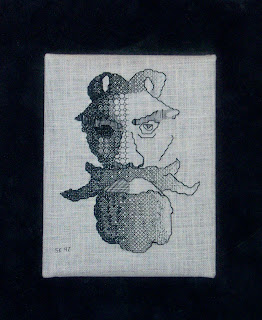I heard it again yesterday. A woman was looking at some of my embroideries just in passing. She glanced at me, smiled, and said, "Just like my grandmother used to make." I beg your pardon; I cannot help but be a little insulted. I grit my teeth, show my canines in a smiling grimace, and for once keep my mouth shut.
I keep in mind that my work reminds other people of work they have seen in their dim pasts. My own grandmother, her sisters, and my great-grandmother were all
stitchers. As far as I know none of them had the passion for embroidery that I do, but
I have examples of work from all of them. It is this passing down of work and traditions that keeps the art of embroidery alive.
But embroidery has gone on from the time of my great grandmother. She was born just after the Civil War and she lived to hear Sputnik beeping across the heavens. She loved
quilting, especially crazy patch. And,
of course, a crazy quilt with stitching on it is considered an embroidery. My Great-Aunt Leona loved tatting. I have a few bits and pieces left from her shuttles. I even have a couple of her shuttles. Leona taught school in
Ault, Colorado before she was married. This was at a time where only two years of college were needed for teaching. Tatting with a shuttle is not embroidery but knotting. However, tatting on a needle is an embroidery. I can show you how to do that.
My own grandmother, Stella Grace, did some needlepoint, some
quilting, and some pillowcases. In fact it was when I spent summers with her in
Holyoke, Colorado that I first did embroidery. I learned the stem stitch, the lazy daisy, and the French knot. It didn't stick at first. When I was twenty-nine and was
accidentally shuttled into a needlepoint class, I had done very little thread and needle since those summers.
My own mother, a
black sheep and a termagant from the word go, also did a bit of needlework as a child. I have two pieces that she did. One is a
pillow top in orange and black. It was a kit in rayon or acetate from the early 30s. A house was printed on it and all she had to do was follow the outlines in stem stitch. The other is a small bag marked laundry, surely for small stuff like underwear. It is cotton with blue bias tape around the edges. It also was a kit, but a stamped cross-stitch one. I keep the treasures of my female line with my own embroideries with the idea of passing them down to my own grandchildren.
As for my own embroidery--some of it I will keep for the passing down, but I have way too much to expect children and grandchildren to store it peacefully all of their lives. So I like to sell it. Oh my embroidery is not like my mother's and grandmother's and my
et cetera's. My embroideries sometimes hang in galleries and museums, not as old work or classic work, but as modern art. So you see, your grandmother's embroideries are not like my embroideries at all.





















